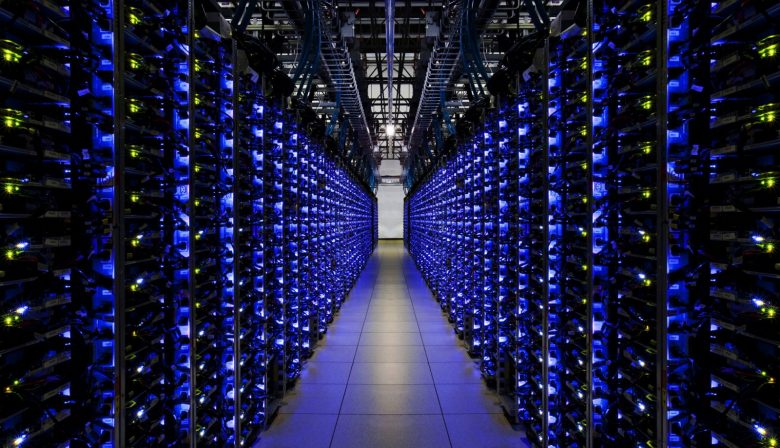After reading the blog ‘Can the Cloud save the environment?’, of fellow BIM student Joram van Rijn, I remembered an interesting news item which I saw a few months ago about the development of data centres in the Netherlands that run on renewable energy. Hence, I made a comment about this and shared my thoughts.
By chance, yesterday evening, the item about the development of giant data centres in the Netherlands using renewable energy was on the news again. In the Wieringermeer, a municipality and polder in the province of North Holland, data centres from Google and Microsoft have been built which fully run on renewable wind energy from the Prinses Ariane Windpark located nearby. For Google and Microsoft, locating data centres in the Netherlands is attractive as they can use renewable energy for making the company ‘greener’. In addition, using the Netherlands as their headquarters provides certain tax advantages.
At first glance, this seems like a very positive development. After all, using renewable energy for the powering of data centres is very sustainable and the fact that these large companies are located here could provide certain economic advantages. However, this does not seem to be the case:
While the development of the Prinses Ariane Windpark was originally meant for empowering 360.000 Dutch households, the data centres of Google and Microsoft currently use 100% of all of the wind energy generated. As a result, locals have been complaining about the fact that these companies use all of ‘their’ promised renewable energy and they only experience nuisance from the park without benefiting. The fact that these households are not able to use Dutch ‘green’ energy and an American company is, does not seem like a positive development to me. Accordingly, the question could be raised what the actual benefit is for the Netherlands if an American company builds a data centre here which uses our renewable energy sources?
One could argue that these data centres provide economic benefits for the government and the involved municipalities, through for example taxes, employment and residual heat. But apparently, Google has directly sold the acquired data centre in order to lease it back from another company via Luxemburg in order to pay as less tax in the Netherlands as possible. In addition, the Google data centre only provides 125 jobs and the temperature of the residual heat is way too low (between 25 and 35 degrees) in order to still use. Finally, the development of the Prinses Ariane Windpark has been heavily subsidized by the Dutch government; in total Vattenfall (the developer) will receive 660 million euros over 15 years. In other words, the Dutch tax payer is paying for the development of a windpark, of which the energy generated is only used by American companies whose presence here does not provide substantial economic benefits for the country as a whole.
In 2019, data centres in the whole of the Netherlands already presented around 3% (4 TWh) of the total electricity consumption (125 TWh). It is expected that by 2030, the data centres of Google and Microsoft in the Wieringermeer will use 8 times more electricity than currently, or around 3.5 TWh yearly. This could possibly provide issues for the Netherlands in concern to achieving their climate goals, as more renewable energy is needed.
Evidently, the development of giant data centres from foreign companies in the Netherlands has significant negative effects without providing significant economic benefits. Moreover, it is expected that under the current circumstances more new data centres will follow. In my opinion, the Dutch government should act as quickly as possible by changing existing regulations in concern to renewable energy use by foreign companies. Providing our own households and companies with ‘green’ energy should be a priority and without providing significant economic benefits for the Netherlands, foreign companies are not welcome.
To conclude, if our small country is to become the hard drive of the world, we certainly need to make sure that we profit from that.
Hollands Kroon. (2020). Zondag met Lubach slaat de plank mis over Prinses Ariane Windpark. Retrieved from: https://www.hollandskroonactueel.nl/2020/10/12/zondag-met-lubach-slaat-de-plank-mis-over-prinses-ariane-windpark/ (Accessed 12 October 2020).
NRC. (2020). Gebroken beloftes: hoe de Wieringermeerpolder dichtslibde met windturbines en datacentra. Retrieved from:https://www.nrc.nl/nieuws/2020/06/05/gebroken-beloftes-hoe-de-wieringermeerpolder-dichtslibde-met-windturbines-en-datacentra-a4001882 (Accessed 12 October 2020).
NRC. (2019). Datacenters verbruiken drie keer zoveel stroom als de NS. Retrieved from:
https://www.nrc.nl/nieuws/2019/05/14/datacenters-verbruiken-drie-keer-zoveel-stroom-als-de-ns-a3960091 (Accessed 12 October 2020).
Zondag met Lubach. (2020). Nederland als harde schijf. Retrieved from: https://www.youtube.com/watch?v=OiPoR9OvD0Y&feature=emb_title (Accessed 12 October 2020).

